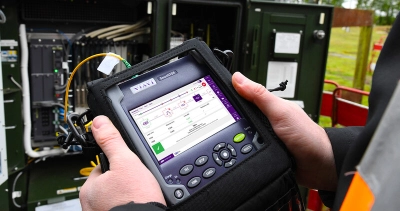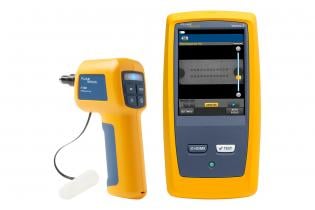High-performance fibre testing equipment is essential for accurate material quality assessment.
High-performance fibre testing equipment is essential for accurate material quality assessment.
Blog Article
Unveiling the Trick Uses of Optical Fiber Checking for Reliable Information Transmission
In the world of modern-day interaction, optical fiber screening emerges as a necessary practice for maximizing data transmission. Recognizing the complex applications of optical fiber screening welcomes a much deeper exploration right into its crucial function in forming the future of data interaction.

Importance of Optical Fiber Testing
The value of optical fiber screening can not be overstated, as it works as a vital element in making certain the integrity and performance of information transmission systems. In an era where high-speed interaction is paramount, any type of deficiencies in fiber optics can lead to significant information loss and minimized performance. As a result, strenuous testing procedures are vital to validate the honesty and efficiency of optical cable televisions.
Evaluating allows for the recognition of flaws such as micro-bends, macrobends, and splice losses that could hinder signal top quality. It provides insights right into the overall depletion and bandwidth abilities of the fibre, ensuring that the network satisfies particular functional standards. Regular testing not only improves system efficiency however also lengthens the life-span of the framework by identifying potential problems before they escalate into expensive failures.

Sorts Of Optical Fibre Examinations
Different sorts of optical fibre tests are conducted to make sure the performance and reliability of fiber optic networks. These tests can be classified into a number of key types, each serving a certain function in assessing the integrity of the fiber.
First, Optical Time Domain Reflectometry (OTDR) is a famous test that recognizes mistakes, entwines, and connectors within the fibre. By sending out pulses of light and analyzing the shown signals, specialists can determine issues along the fibre's length.
Second, insertion loss examinations examine the quantity of signal loss when light passes through adapters or splices, which is critical for keeping network efficiency.
Third, return loss tests gauge the quantity of light mirrored back in the direction of the resource, providing insights into the quality of connections and potential resources of disturbance.
Additionally, connection tests guarantee that the fiber course is total, enabling technicians to validate that the fibre is intact without any breaks. optical fibre diameter analyser.
Finally, aesthetic fault locators utilize visible light to determine breaks or severe bends in the fiber, assisting in fast troubleshooting. Jointly, these examinations form a detailed technique to preserving optimal efficiency in fibre optic networks.

Applications in Network Upkeep
In modern telecommunications, reliable network upkeep counts heavily on optical fibre testing to recognize and correct concerns immediately. Normal screening guarantees that the network operates at ideal efficiency levels, reducing downtime and improving user experience.
Among the main applications of optical fiber screening in maintenance is the detection of mistakes, such as breaks, flexes, or incorrect links. Techniques like Optical Time Domain Reflectometry (OTDR) allow specialists to situate these issues accurately and analyze the quality of the fiber link. In addition, loss screening confirms the honesty of the optical course, guaranteeing that signal depletion stays within acceptable limitations.
Routine upkeep testing additionally assists in safety nets, determining prospective troubles before they rise into considerable failures. This positive strategy can conserve link companies both time and financial resources. During upgrades or growths, optical fiber testing makes sure that brand-new installations integrate perfectly with existing facilities.
Enhancing Information Transmission Integrity
Effective network upkeep through optical fibre testing not only addresses prompt concerns however additionally plays a substantial duty in boosting data transmission reliability. By identifying faults, measuring signal loss, and examining the total condition of fibre optic cables, testing ensures that potential problems are remedied prior to they escalate right into substantial interruptions.
Normal optical fiber testing, such as time-domain reflectometry (TDR) and optical time-domain reflectometry (OTDR), allows technicians to pinpoint the exact areas of breaks, flexes, or port concerns within the network. This navigate to this website proactive method not only minimizes downtime yet likewise optimizes the efficiency of data transmission by making certain that the paths for signals are clear and working efficiently.
Furthermore, testing help in confirming adherence to industry requirements and specifications, which is crucial for keeping the honesty of data flow. By making sure that each link meets needed thresholds for loss and top quality, organizations can boost their self-confidence in the reliability of their data networks.
Ultimately, purchasing thorough optical fibre testing not only enhances information transmission integrity yet also supports the lasting functional efficiency of interaction infrastructures.
Future Patterns in Fiber Screening
Emerging modern view it technologies are poised to transform fibre screening, leading the method for improved performance and accuracy in information transmission diagnostics (optical fibre testing equipment). As the demand for faster net and greater data transfer continues to climb, the integration of sophisticated devices such as artificial intelligence (AI) and device discovering (ML) is set to change standard fibre screening techniques. These innovations will certainly allow anticipating maintenance and automated fault discovery, dramatically minimizing downtime and improving network reliability
In addition, the fostering of Net of Points (IoT) tools will promote real-time monitoring of fiber networks, permitting instant identification of performance problems. This change towards positive management will minimize interruptions and enhance data flow.
Furthermore, innovations in optical time-domain reflectometry (OTDR) and brand-new testing criteria will improve the accuracy of dimensions, guaranteeing that data honesty is kept throughout the transmission procedure. The development of 5G technology likewise demands the advancement of much more innovative fiber screening strategies to support its high-speed demands.
Conclusion
To conclude, optical fibre screening is crucial for preserving reliable data transmission within communication networks. By utilizing numerous testing techniques, such as OTDR and insertion loss examinations, prospective faults can be recognized and fixed, thus improving signal clarity and lessening downtime. Regular screening not only ensures conformity with industry standards yet additionally promotes proactive upkeep, ultimately contributing to the lasting integrity and performance of fiber optic systems. The continued advancement of testing methodologies will certainly better strengthen these capacities in the future.
Report this page